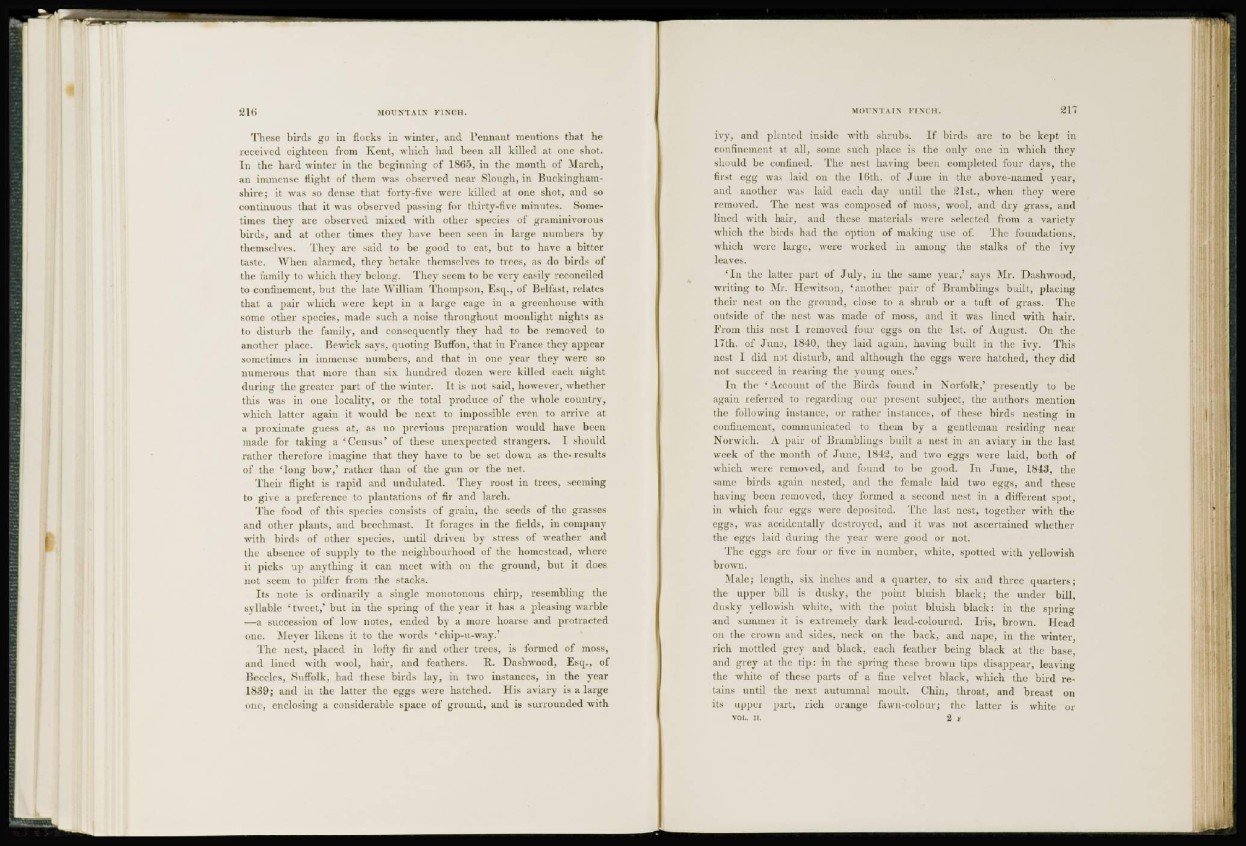
816 MOUNTAIN "FINCH.
These birds go in flocks in winter, and Pennant mentions that he
received eighteen from Kent, which had been all killed at one shot.
In the hard winter in the beginning of 1805, in the month of March,
an immense flight of them was observed near Slough, in Buckinghamshire;
it was so dense that forty-five were killed at one shot, and so
continuous that it was observed passing for thirty-five minutes. Sometimes
they are observed mixed with other species of graminivorous
birds, and at other times they have been seen in large numbers by
themselves. They are said to be good to cat, but to have a bitter
taste. When alarmed, they betake themselves to trees, as do birds of
the family to which thev belong. They seem to be very easily reconciled
to confinement, but the Late William Thompson, Esq., of Belfast, relates
that a pair which were kept in a large cage in a greenhouse with
some other species, made such a noise throughout moonlight nights as
to disturb the family, and consequently they had to be removed to
another place. Bewick says, quoting Buffon, that in France they appear
sometimes in immense numbers, and that in one year they were so
numerous that more than six hundred dozen were killed each night
during the greater part of the winter. It is not said, however, whether
this was in one locality, or the total produce of the whole country,
which latter again it would be next to impossible even to arrive at
a proximate guess at, as no previous preparation would have been
made for taking a 'Census' of these unexpected strangers. 1 should
rather therefore imagine that they have to be set down as the- results
of the ' long bow,' rather than of the gun or the net.
Their flight is rapid and undulated. They roost in trees, seeming
to give a preference to plantations of fir and larch.
The food of this species ('(insists of grain, the seeds of the grnsses
and other plants, and beechmast. It forages in the fkdds, in company
with birds of other species, until driven by stress of weather and
the absence of supply to the neighbourhood of the homestead, where
it picks up anything it can meet with on the ground, but it does
not seem to pilfer from the stacks.
Its note is ordinarily a single monotonous chirp, resembling the
syllable 'tweet,' but in the spring of the year it has a pleasing warble
—a succession of low notes, ended by a more hoarse and protracted
one. Meyer likens it to the words ' chip-u-way.'
The nest, placed in lofty fir and other trees, is formed of moss,
and lined with wool, hair, and feathers. R. Dashwood, Esq., of
Beccles, Suffolk, had these birds lay, in two instances, in the year
1839; and in the latter the eggs were hatched. His aviary is a large
one, enclosing a considerable space of ground, and is surrouuded with
MOUNTAIN FINCH. 217
ivy, and planted inside with shrubs. If birds are to be kept in
confinement at all, some such place is the only one in which they
should be confined. The nest having been completed four days, the
first egg was laid on the 16th. of June in the above-named year,
and another was laid each day until the 21st., when they were
removed. The nest was composed of moss, wool, and dry grass, and
lined with hair, and these materials were; selected from a variety
which the birds had the option of making use of. The foundations,
which were large, were worked in among the stalks of the ivy
leaves.
'In the latter part of July, in the same year,' says Mr. Dashwood,
writing to Mr. Hewitson, 'another pair of Brambliugs built, placing
their nest on the ground, close to a shrub or a tuft of grass. The
outside of the nest was made of moss, and it was lined with hair.
From this nest I remuved four eggs on the 1st. of August. On the
17th. of June, 1840, they laid again, having built in the ivy. This
nest I did not disturb, and although the eggs were hatched, they did
not succeed in rearing the young ones.*
In the 'Account of the Birds found in Norfolk,* presently to be
again referred to regarding our present subject, the authors mention
the following instance, or rather instances, of these birds nesting in
confinement, communicated to them by a gentleman residing near
Norwich. A pair of Brambliugs built a nest in an aviary in the last
week of the month of June, 1842, and two eggs were laid, both of
which were removed, and found to be good. In June, 1843, the
same birds again nested, and the female laid two eggs, and these
having been removed, they formed a second nest in a different spot,
in which four eggs were deposited. The last nest, together with the
eggs, was accidentally destroyed, and it was not ascertained whether
the eggs laid during the year were good or not.
The eggs arc four or five in number, white, spotted with yellowish
brown.
Male; length, six inches and a quarter, to six and three quarters;
the upper bill is dusky, the point bluish black; the under bill,
dusky yellowish white, with the point bluish black: in the spring
and summer it is extremely dark lead-coloured. Iris, brown. Head
on the crown and sides, neck on the back, and nape, in the winter,
rich mottled grey and black, each feather being black at the base,
and grey at the tip: in the spring these brown tips disappear, leaving
the white of these parts of a fine velvet black, which the bird retains
until the next autumnal moult. Chin, throat, and breast on
its upper part, rich orange fawn-colour; the latter is white or
VOL. II. 2 I